Papers by george ricaurte
The Journal of Neuroscience, 2002
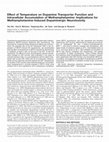
The Journal of Neuroscience, 2000
Hyperthermia exacerbates and hypothermia attenuates methamphetamine (METH)-induced dopamine (DA) ... more Hyperthermia exacerbates and hypothermia attenuates methamphetamine (METH)-induced dopamine (DA) neurotoxicity. The mechanisms underlying these temperature effects are unknown. Given the essential role of the DA transporter (DAT) in the expression of METH-induced DA neurotoxicity, we hypothesized that the effect of temperature on METH-induced DA neurotoxicity is mediated, at least in part, at the level of the DAT. To test this hypothesis, the effects of small, physiologically relevant temperature changes on DAT function were evaluated in two types of cultured neuronal cells: (1) a neuroblastoma cell line stably transfected with human DAT cDNA and (2) rat embryonic mesencephalic primary cells that naturally express the DAT. Temperatures for studies of DAT function were selected based on core temperature measurements in animals exposed to METH under usual ambient (22°C) and hypothermic (6°C) temperature conditions, where METH neurotoxicity was fully expressed and blocked, respectively. DAT function, determined by measuring accumulation of radiolabeled DA and 1-methyl-4-phenylpyridinium (MPP ϩ), was found to directly correlate with temperature, with higher levels of substrate uptake at 40°C, intermediate levels at 37°C, and lower levels at 34°C. DAT-mediated accumulation of METH also directly correlated with temperature, with greater accumulation at higher temperatures. These findings indicate that relatively small, physiologically relevant changes in temperature significantly alter DAT function and intracellular METH accumulation, and suggest that the effect of temperature on METHinduced DA neurotoxicity is mediated, at least in part, at the level of the DAT.
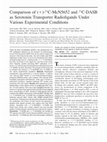
Journal of nuclear medicine : official publication, Society of Nuclear Medicine, 2002
There has been considerable interest in the development of a PET radioligand selective for the se... more There has been considerable interest in the development of a PET radioligand selective for the serotonin (5-hydroxytryptamine [5-HT]) transporter (SERT) that can be used to image 5-HT neurons in the living human brain. The most widely used SERT radiotracer to date, trans-1,2,3,5,6,10-beta-hexahydro-6-[4-(methylthio)phenyl[pyrrolo-[2,1-a]isoquinoline ((+)-(11)C-McN5652), has been successful in this regard but may have some limitations. Recently, another promising SERT radiotracer, 3-(11)C-amino-4-(2-dimethylaminomethylphenylsulfanyl)benzonitrile ((11)C-DASB), has been described. The purpose of this study was to compare and contrast (+)-(11)C-McN5652 and (11)C-DASB under various experimental conditions. Radioligand comparisons were performed in a control baboon, a baboon with reduced SERT density ((+/-)-3,4-methylenedioxymethamphetamine [MDMA] lesion), and a baboon with reduced SERT availability (paroxetine pretreatment). Under each of these experimental conditions, repeated (triplica...
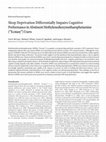
Journal of Neuroscience, 2009
Methylenedioxymethamphetamine (MDMA; "Ecstasy") is a popular recreational drug and brain serotoni... more Methylenedioxymethamphetamine (MDMA; "Ecstasy") is a popular recreational drug and brain serotonin (5-HT) neurotoxin. Neuroimaging data indicate that some human MDMA users develop persistent deficits in brain 5-HT neuronal markers. Although the consequences of MDMA-induced 5-HT neurotoxicity are not fully understood, abstinent MDMA users have been found to have subtle cognitive deficits and altered sleep architecture. The present study sought to test the hypothesis that sleep disturbance plays a role in cognitive deficits in MDMA users. Nineteen abstinent MDMA users and 21 control subjects participated in a 5 d inpatient study in a clinical research unit. Baseline sleep quality was measured using the Pittsburgh Sleep Quality Inventory. Cognitive performance was tested three times daily using a computerized cognitive battery. On the third day of admission, subjects began a 40 h sleep deprivation period and continued cognitive testing using the same daily schedule. At baseline, MDMA users performed less accurately than controls on a task of working memory and more impulsively on four of the seven computerized tests. During sleep deprivation, MDMA users, but not controls, became increasingly impulsive, performing more rapidly at the expense of accuracy on tasks of working and short-term memory. Tests of mediation implicated baseline sleep disturbance in the cognitive decline seen during sleep deprivation. These findings are the first to demonstrate that memory problems in MDMA users may be related, at least in part, to sleep disturbance and suggest that cognitive deficits in MDMA users may become more prominent in situations associated with sleep deprivation.
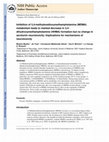
Synapse, 2011
3,4-Methylenedioxymethamphetamine (MDMA)'s O-demethylenated metabolite, 3,4dihydroxymethamphetami... more 3,4-Methylenedioxymethamphetamine (MDMA)'s O-demethylenated metabolite, 3,4dihydroxymethamphetamine (HHMA), has been hypothesized to serve as a precursor for the formation of toxic catechol thioether metabolites (e.g. 5-N-acetylcystein-S-yl-HHMA) that mediate 3,4-methylenedioxymethamphetamine (MDMA) neurotoxicity. To further test this hypothesis, HHMA formation was blocked with dextromethorphan (DXM), which competitively inhibits cytochrome P450 enzyme-mediated O-demethylenation of MDMA to HHMA. In particular, rats were randomly assigned to one of four treatment groups (N= 9-12 per group): 1) Saline/MDMA; 2) DXM/MDMA; 3) DXM/Saline; 4) Saline/Saline. During drug exposure, timeconcentration profiles of MDMA and its metabolites were determined, along with body temperature. One week later, brain serotonin (5-HT) neuronal markers were measured in the same animals. DXM did not significantly alter core temperature in MDMA-treated animals. A large (greater that 70%) decrease in HHMA formation had no effect on the magnitude of MDMA neurotoxicity. These results cast doubt on the role of HHMA-derived catechol thioether metabolites in the mechanism of MDMA neurotoxicity.
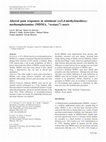
Psychopharmacology, 2011
Rationale (±)3,4-Methylenedioxymethamphetamine (MDMA) is a popular recreational drug that has pot... more Rationale (±)3,4-Methylenedioxymethamphetamine (MDMA) is a popular recreational drug that has potential to damage brain serotonin (5-HT) neurons in humans. Brain 5-HT neurons play a role in pain modulation, yet little is known about long-term effects of MDMA on pain function. Notably, MDMA users have been shown to have altered sleep, a phenomenon that can lead to altered pain modulation. Objectives This study sought to assess pain processing in MDMA users using objective methods, and explore potential relationships between pain processing and sleep indices. Methods Forty-two abstinent MDMA users and 43 agematched controls participated in a 5-day inpatient study. Outcome measures included standardized measures of pain, sleep polysomnograms, and power spectral measures of the sleep EEG. When differences in psychophysiological measures of pain were found, the relationship between pain and sleep measures was explored. Results MDMA users demonstrated lower pressure pain thresholds, increased cold pain ratings, increased pain ratings during testing of diffuse noxious inhibitory control, and decreased Stage 2 sleep. Numerous significant relationships between sleep and pain measures were identified, but differences in sleep between the two groups were not found to mediate altered pain perception in MDMA users. Conclusions Abstinent MDMA users have altered pain perception and sleep architecture. Although pain and sleep outcomes were related, differences in sleep architecture in MDMA users did not mediate altered pain responses. It remains to be determined whether alterations in pain perception in MDMA users are secondary to neurotoxicity of 5-HT-mediated pain pathways or alterations in other brain processes that modulate pain perception.
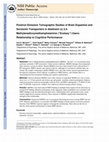
Psychopharmacology, 2008
Rationale-(±)3,4-Methylenedioxymethamphetamine (MDMA, "Ecstasy") is a recreational drug and brain... more Rationale-(±)3,4-Methylenedioxymethamphetamine (MDMA, "Ecstasy") is a recreational drug and brain serotonin (5-HT) neurotoxin. Under certain conditions, MDMA damages brain dopamine (DA) neurons, at least in rodents. Human MDMA users have been found to have reduced brain 5-HT transporter (SERT) density and cognitive deficits, although it is not known whether these are related. We sought to determine whether MDMA users who take closely spaced sequential doses develop DA transporter (DAT) deficits, in addition to SERT deficits, and whether there is a relationship between transporter binding and cognitive performance. Methods-Sixteen abstinent MDMA users with a history of sequential MDMA use (two or more doses over a 3-12 hour period) and sixteen age and gender-matched controls participated. Subjects underwent positron emission tomography with the DAT and SERT radioligands, [ 11 C]WIN 35,428 and [ 11 C]DASB, respectively. Subjects also underwent formal neuropsychiatric testing. Results-MDMA users had reduced SERT binding in multiple brain regions but no reductions in striatal DAT binding. Memory performance in the aggregate subject population was correlated with SERT binding in the dorsolateral prefrontal cortex, orbitofrontal cortex and parietal cortex, brain regions implicated in memory function. Prior exposure to MDMA significantly diminished the strength of this relationship. Conclusions-Sequential MDMA use is associated with lasting decreases in brain SERT, but not DAT. Memory performance is associated with SERT binding in brain regions involved in memory function. Prior MDMA exposure appears to disrupt this relationship. These data are the first to directly relate memory performance to brain SERT density.
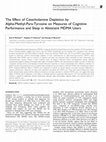
Neuropsychopharmacology, 2007
Methylenedioxymethamphetamine (MDMA) is a popular recreational drug of abuse and a brain serotoni... more Methylenedioxymethamphetamine (MDMA) is a popular recreational drug of abuse and a brain serotonin (5-HT) neurotoxin in animals. Growing evidence suggests that humans who use MDMA recreationally can also develop 5-HT neurotoxic injury, although functional consequences have been difficult to identify. Twenty-five abstinent MDMA users and 23 non-MDMA using controls were studied to determine whether pharmacologic depletion of brain catecholamines by alpha-methyl-para-tyrosine (AMPT) would differentially effect MDMA users on measures of cognition and sleep, two processes dually modulated by brain serotonergic and catecholaminergic neurons. During a 5-day in-patient study, all subjects underwent formal neuropsychiatric testing, repeated computerized cognitive testing, and all-night sleep studies. At baseline, MDMA users had performance deficits on tasks of verbal and visuospatial working memory and displayed increased behavioral impulsivity on several computerized tasks, reflecting a tendency to perform quickly at the expense of accuracy. Baseline sleep architecture was also altered in abstinent MDMA users compared to controls. AMPT produced differential effects in MDMA users compared to controls on several cognitive and sleep measures. Differences in cognitive performance, impulsivity, and sleep were significantly correlated with MDMA use. These data extend findings from earlier studies demonstrating cognitive deficits, behavioral impulsivity, and sleep alterations in abstinent MDMA users, and suggest that lasting effects of MDMA lead to alterations in the ability to modulate behaviors reciprocally influenced by 5-HT and catecholamines. More research is needed to determine potential relationships between sleep abnormalities, cognitive deficits and impulsive behavior in abstinent MDMA users.
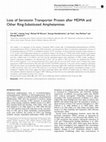
Neuropsychopharmacology, 2007
We studied in vivo expression of the serotonin transporter (SERT) protein after 3,4-methylenediox... more We studied in vivo expression of the serotonin transporter (SERT) protein after 3,4-methylenedioxymethamphetamine (MDMA), p-chloroamphetamine (PCA), or fenfluramine (FEN) treatments, and compared the effects of substituted amphetamines to those of 5,7-dihydroxytryptamine (5,7-DHT), an established serotonin (5-HT) neurotoxin. All drug treatments produced lasting reductions in 5-HT, 5-HIAA, and [ 3 H]paroxetine binding, but no significant change in the density of a 70 kDa band initially thought to correspond to the SERT protein. Additional Western blot studies, however, showed that the 70 kDa band did not correspond to the SERT protein, and that a diffuse band at 63-68 kDa, one that had the anticipated regional brain distribution of SERT protein (midbrain4 striatum4neocortex4cerebellum), was reduced after 5,7-DHT and was absent in SERT-null animals, was decreased after MDMA, PCA, or FEN treatments. In situ immunocytochemical (ICC) studies with the same two SERT antisera used in Western blot studies showed loss of SERT-immunoreactive (IR) axons after 5,7-DHT and MDMA treatments. In the same animals, tryptophan hydroxylase (TPH)-IR axon density was comparably reduced, indicating that serotonergic deficits after substituted amphetamines differ from those in SERT-null animals, which have normal TPH levels but, in the absence of SERT, develop apparent neuroadaptive changes in 5-HT metabolism. Together, these results suggest that lasting serotonergic deficits after MDMA and related drugs are unlikely to represent neuroadaptive metabolic responses to changes in SERT trafficking, and favor the view that substituted amphetamines have the potential to produce a distal axotomy of brain 5-HT neurons.
Neuropsychopharmacology, 1994
Methylenedioxymethamphetamine (MDMA; "Ecstasy"), an increasingly popular recreational drug, is kn... more Methylenedioxymethamphetamine (MDMA; "Ecstasy"), an increasingly popular recreational drug, is known to damage brain serotonin 5-hydroxytryptamine (5-HT) neurons in experimental animals. Whether MDMA is neurotoxic in humans has not been established. Thirty MDMA users and 28 controls were admitted to a controlled inpatient setting for measurement of biologic and behavioral indexes of central 5-HT function. Outcome measures obtained after at least 2 weeks of drug abstinence included concentrations of monoamine metabolites in cerebrospinal fluid (CSF), prolactin responses to L-tryptophan, nociceptive responses to ischemic pain, and personality characteristics in which 5-HT has been implicated (i.e., impulsivity and aggression). Subjects with a history of MDMA exposure had lower levels of CSF 5-hydroxyindoleacetic acid
Neuropsychopharmacology, 2001
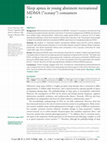
Neurology, 2011
Background: Methylenedioxymethamphetamine (MDMA, "ecstasy") is a popular recreational drug of abu... more Background: Methylenedioxymethamphetamine (MDMA, "ecstasy") is a popular recreational drug of abuse and a selective brain serotonin neurotoxin. Functional consequences of MDMA neurotoxicity have defied ready characterization. Obstructive sleep apnea (OSA) is a common form of sleepdisordered breathing in which brain serotonin dysfunction may play a role. The present study sought to determine whether abstinent recreational MDMA users have an increased prevalence of OSA. Methods: We studied 71 medically healthy recreational MDMA users and 62 control subjects using all-night sleep polysomnography in a controlled inpatient research setting. Rates of apneas, hypopneas, and apnea hypopnea indices were compared in the 2 groups, controlling for body mass index, age, race, and gender. Results: Recreational MDMA users who had been drug free for at least 2 weeks had significantly increased rates of obstructive sleep apnea and hypopnea compared with controls. The odds ratio (95% confidence interval) for sleep apnea (mild, moderate, and severe combined) in MDMA users during non-REM sleep was 8.5 (2.4-30.4), which was greater than that associated with obesity [6.9 (1.7-28.2)]. Severity of OSA was significantly related to lifetime MDMA exposure. Conclusions: These findings suggest that prior recreational methylenedioxymethamphetamine use increases the risk for obstructive sleep apnea and lend support to the notion that brain serotonin neuronal dysfunction plays a role in the pathophysiology of sleep apnea. Neurology ® 2009; 73:2011-2017 GLOSSARY AHI ϭ apnea hypopnea index; BMI ϭ body mass index; DSM-IV ϭ Diagnostic and Statistical Manual of Mental Disorders, 4th edition; MDMA ϭ methylenedioxymethamphetamine; NREM ϭ non-REM; OR ϭ odds ratio; OSA ϭ obstructive sleep apnea; PSG ϭ polysomnography; SCID-I ϭ Scheduled Diagnostic Interview for DSM-IV; SDB ϭ sleep-disordered breathing.
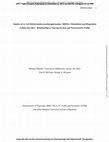
Journal of Pharmacology and Experimental Therapeutics, 2012
The neurotoxicity of (±) 3,4-methylenedioxymethamphetamine (MDMA, "Ecstasy") is influenced by tem... more The neurotoxicity of (±) 3,4-methylenedioxymethamphetamine (MDMA, "Ecstasy") is influenced by temperature and varies according to species. The mechanisms underlying these two features of MDMA neurotoxicity are unknown, but differences in MDMA metabolism have recently been implicated in both. The present study was designed to: 1) assess the effect of hypothermia on MDMA metabolism; 2) determine whether the neuroprotective effect of hypothermia is related to inhibition of MDMA metabolism; and 3) determine if different neurotoxicity profiles in mice and rats are related to differences in MDMA metabolism and/or disposition in the two species. Rats and mice received single neurotoxic oral doses of MDMA at 25°C and 4°C, and body temperature, pharmacokinetic parameters and serotonergic and dopaminergic neuronal markers were measured. Hypothermia did not alter MDMA metabolism in rats, and only modestly inhibited MDMA metabolism in mice; however, it afforded complete neuroprotection in both species. Rats and mice metabolized MDMA in a similar pattern, with 3,4-methylenedioxyamphetamine being the major metabolite, followed by 4-hydroxy-3methoxymethamphetamine and 3,4-dihydroxymethamphetamine, respectively. Differences between MDMA pharmacokinetics in rats and mice, including faster elimination in mice, did not account for the different profile of MDMA neurotoxicity in the two species. Taken together, the results of these studies indicate that inhibition of MDMA metabolism is not responsible for the neuroprotective effect of hypothermia in rodents, and that different neurotoxicity profiles in rats and mice are not readily explained by differences in MDMA metabolism or disposition.
Forensic Science International, 2009
Simultaneous liquid chromatographic-electrospray ionization mass spectrometric quantification of ... more Simultaneous liquid chromatographic-electrospray ionization mass spectrometric quantification of 3,4methylenedioxymethamphetamine (MDMA, Ecstasy) and its metabolites 3,4-dihydroxymethamphetamine, 4-hydroxy-3methoxymethamphetamine and 3,4-methylenedioxyamphetamine in squirrel monkey and human plasma after acidic conjugate cleavage
Chemical Research in Toxicology, 1992
The genotoxic activity of acrylamide. Enuiron. Mol. Mutagen. 11, an aid to drug development. B o g .
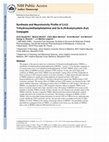
Chemical Research in Toxicology, 2011
The purpose of the present study was to determine if trihydroxymethamphetamine (THMA), a metaboli... more The purpose of the present study was to determine if trihydroxymethamphetamine (THMA), a metabolite of methylenedioxymethamphetamine (MDMA, "ecstasy") or its thioether conjugate, 6-(N-acetylcystein-S-yl)-2,4,5-trihydroxymethamphetamine (6-NAC-THMA), plays a role in the lasting effects of MDMA on brain serotonin (5-HT) neurons. To this end, novel high-yield syntheses of THMA and 6-NAC-THMA were developed. Lasting effects of both compounds on brain serotonin (5-HT) neuronal markers were then examined. A single intraventricular injection of THMA produced a significant lasting depletion of regional rat brain 5-HT and 5hydroxyindoleacetic acid (5-HIAA), consistent with previous reports that THMA harbors 5-HT neurotoxic potential. The lasting effect of THMA on brain 5-HT markers was blocked by the 5-HT uptake inhibitor fluoxetine, indicating persistent effects of THMA on 5-HT markers, like those of MDMA, are dependent on intact 5-HT transporter function. Efforts to identify THMA in the brains of animals treated with a high, neurotoxic dose (80 mg/kg) of MDMA were unsuccessful. Inability to identify THMA in brains of these animals was not related to the unstable nature of the THMA molecule, because exogenous THMA administered intracerebroventricularly could be readily detected in the rat brain for several hours. The thioether conjugate of THMA, 6-NAC-THMA, led to no detectable lasting alterations of cortical 5-HT or 5-HIAA levels, indicating that it lacks significant 5-HT neurotoxic activity. The present results cast doubt on the role of either THMA or 6-NAC-THMA in the lasting serotonergic effects of MDMA. The possibility remains that different conjugated forms of THMA, or oxidized cyclic forms (e.g. the indole of THMA) play a role in MDMA-induced 5-HT neurotoxicity in vivo.
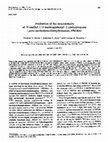
Brain Research, 1992
These studies assessed the neurotoxic potential of N-methyl-l-(4-methoxyphenyl)-2-aminopropane (p... more These studies assessed the neurotoxic potential of N-methyl-l-(4-methoxyphenyl)-2-aminopropane (para-methoxymethamphetamine; PMMA), an amphetamine analog that has surfaced in the illicit drug market. Repeated subcutaneous injections of PMMA caused lasting, dose-related reductions in regional brain concentrations of serotonin (5-HT) and 5-hydroxyindoleacetic acid (5-HIAA), and in the density of [3H]paroxetinelabelled 5-HT uptake sites. Comparison of the neurotoxic potential of PMMA to that of para-methoxyamphetamine (PMA) and 3,4-methylenedioxymethamphetamine (MDMA) showed that equivalent doses of PMMA and PMA (80 mg/kg) produced comparable depletions of 5-HT, but that these depletions were not as pronounced as those induced by a lower dose of MDMA (20 mg/kg). Striatal DA was not affected on a long-term basis by any of the ring-substituted amphetamines evaluated in this study. These data suggest that PMMA, like PMA and MDMA, produces long-term (possibly neurotoxic) effects on brain serotonin neurons, but that PMMA is less potent than MDMA as a 5-HT neurotoxin. Further, they raise concern over the illicit use of PMMA since humans could be more sensitive than rodents to the 5-HT neurotoxic effects of PMMA and related drugs.
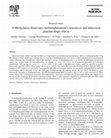
Brain Research, 1997
The present studies further examined the effect of N-methylation on the behavioral and neurotoxic... more The present studies further examined the effect of N-methylation on the behavioral and neurotoxic effects of methamphetamine. Drug discrimination studies employing a training dose of 1 mgrkg of methamphetamine were used to confirm and extend previous behavioral studies indicating that N-methylation reduced the behavioral activity of methamphetamine 5-to 10-fold. In subsequent neurotoxicity Ž. studies, rats received doses of methamphetamine 10 mgrkg, s.c., every 6 h =5 or its N-methylated derivative, N, N-dimethyl-Ž. amphetamine 100 mgrkg, s.c., every 6 h =5 that, based on the results of the behavioral studies, would be expected to produce Ž. behaviorally equivalent effects. Saline-treated rats served as controls. Two weeks after treatment, the status of brain dopamine DA and Ž. serotonin 5-HT neurons was assessed by measuring DA and 5-HT axon terminal markers. As anticipated, methamphetamine produced neurochemical deficits indicative of DA and 5-HT axon terminal damage. By contrast, despite the fact that it was given at a dose behaviorally equivalent to methamphetamine, N-N-dimethylamphetamine failed to produce signs of DA or 5-HT neurotoxicity. These results indicate that N-methylation dissociates methamphetamine's neurotoxic and behavioral pharmacologic effects, and suggest that it may be possible to separate the neurotoxic and pharmacologic effects of other substituted amphetamine derivatives with potentially useful Ž. clinical activity e.g. fenfluramine and methylenedioxymethamphetamine. q 1997 Elsevier Science B.V.
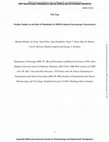
Drug Metabolism and Disposition, 2009
The mechanism by which the recreational drug (±) 3, 4-methylenedioxymethamphetamine (MDMA) destro... more The mechanism by which the recreational drug (±) 3, 4-methylenedioxymethamphetamine (MDMA) destroys brain serotonin (5-HT) axon terminals is not understood. Recent studies have implicated MDMA metabolites but their precise role remains unclear. To further evaluate the relative importance of metabolites versus the parent compound in neurotoxicity, the present study explored the relationship between pharmacokinetic parameters of MDMA, 3,4-methylenedioxyamphetamine (MDA), 3,4-dihydroxymethamphetamine (HHMA) and 4-hydroxy-3-methoxymethamphetamine (HMMA) and indexes of serotonergic neurotoxicity in the same animals. The present study also further evaluated the neurotoxic potential of 5-(N-acetylcystein-S-yl)-HHMA (5-NAC-HHMA), an MDMA metabolite recently implicated in 5-HT neurotoxicity. Lasting serotonergic deficits correlated strongly with pharmacokinetic parameters of MDMA (C max and AUC), more weakly with those of MDA, and not at all with those of HHMA or HMMA (total amounts of the free analytes obtained after conjugate cleavage). HHMA and HMMA could not be detected in the brains of animals with high brain MDMA concentrations and high plasma HHMA and HMMA concentrations, suggesting that HHMA and HMMA do not readily penetrate the blood brain barrier (either in their free form or as sulfate or glucuronic conjugates) and that little or no MDMA is metabolized to HHMA or HMMA in the brain. Repeated intraparenchymal administration of 5-NAC-HHMA did not produce significant lasting serotonergic deficits in the rat brain. Taken together, these results indicate that MDMA and, possibly, MDA are more important determinants of brain 5-HT neurotoxicity in the rat than HHMA and HMMA, and bring into question the role of metabolites (including 5-NAC-HHMA) in MDMA neurotoxicity.
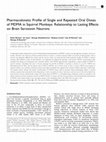
Neuropsychopharmacology, 2005
A large body of data indicates that (7)3,4-methylenedioxymethamphetamine (MDMA, 'ecstasy') can da... more A large body of data indicates that (7)3,4-methylenedioxymethamphetamine (MDMA, 'ecstasy') can damage brain serotonin neurons in animals. However, the relevance of these preclinical data to humans is uncertain, because doses and routes of administration used in animals have generally differed from those used by humans. Here, we examined the pharmacokinetic profile of MDMA in squirrel monkeys after different routes of administration, and explored the relationship between acute plasma MDMA concentrations after repeated oral dosing and subsequent brain serotonin deficits. Oral MDMA administration engendered a plasma profile of MDMA in squirrel monkeys resembling that seen in humans, although the half-life of MDMA in monkeys is shorter (3 vs 6-9 h). MDMA was biotransformed into MDA, and the plasma ratio of MDA to MDMA was 3-5/100, similar to that in humans. MDMA accumulation in squirrel monkeys was nonlinear, and plasma levels were highly correlated with regional brain serotonin deficits observed 2 weeks later. The present results indicate that plasma concentrations of MDMA shown here to produce lasting serotonergic deficits in squirrel monkeys overlap those reported by other laboratories in some recreational 'ecstasy' consumers, and are two to three times higher than those found in humans administered a single 100-150 mg dose of MDMA in a controlled setting. Additional studies are needed on the relative sensitivity of brain serotonin neurons to MDMA toxicity in humans and non-human primates, the pharmacokinetic parameter(s) of MDMA most closely linked to the neurotoxic process, and metabolites other than MDA that may play a role.











Uploads
Papers by george ricaurte